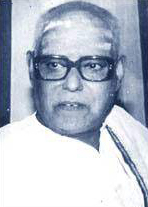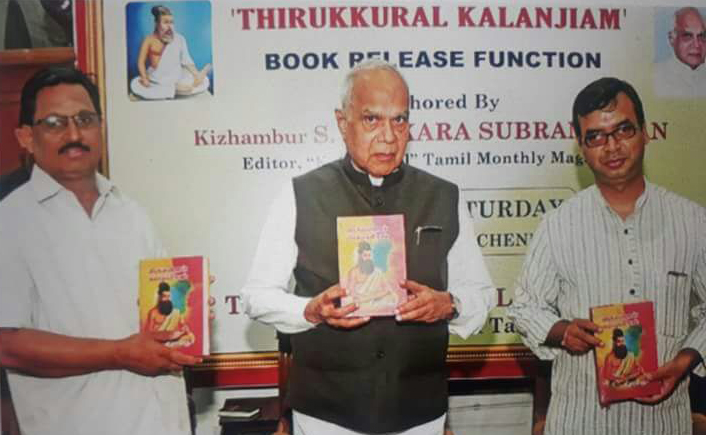Registered with the Registrar of Newspapers for India under R.N.I 53640/91
Vol. XXXII No. 4, June 1-15, 2022
Kalaimagal, the literary Tamil monthly turns 90
-- by R.V. Rajan, rvrajan42@gmail.com
As a new initiative, the Madras Management Association has begun to conduct a series of meetings in Tamil, so that is can cater to its members in Tamil Nadu who are more comfortable listening to lectures in the said language. The third speaker in the series was Kizhambur Sankarasubramanian, the fourth editor of the 90 year-old Tamil literary magazine Kalaimagal – a unique periodical which has appeared, month after month, without fail in the last nine decades. Even during the lockdown, it appeared in digital form to delight its loyal readers. Considering that many other Tamil magazines have disappeared because of myriad market pressures including that of Covid, it is a remarkable achievement indeed.
The idea of starting a Tamil literary magazine was conceived at the home of P.N. Appuswamy in Chitrakulam, Mylapore, during a gathering of Tamil scholars. U.V. Swaminatha Iyer (U Ve Sa) – popularly known as Tamizh Thatha – not only offered to edit the magazine but also gave it the name Kalaimagal. R. Narayanaswamy Iyerof Madras Law Journal fame offered to print and publish it – a legacy his son and grandson have carried forward for over eight decades. Five years ago, the publishing rights were bought over by P.T.T. Rajan, the current publisher of the magazine.
Located in the office of Madras Law Journal on 83, Mundaga Kanniamman Street, the first issue of the magazine came out in January1932. The annual subscription was fixed at Rs. 4 within the country and Rs. 5 for readers abroad. It carried literature, fine arts, science, children’s stories as well as pages exclusively meant for women. From distributing 1,500 copies in the beginning, it grew to reach over one lakh copies during the mid sixties and seventies.
The magazine’s first editor, Swaminatha Iyer, was a Tamil scholar who spent his lifetime collecting rare palm leaf writings of Tamil Sangam classics and publishing them at his own expense. But for his initiative, the Tamil world would never have come to know about iconic works such as the Silappathikkaram, Manimekalai and more. He contributed one article each issue, and the value and esteem of the magazine grew by leaps and bounds. He was the editor from 1932 to 1938.
 K.V. Jagannathan (KiVaJa).
K.V. Jagannathan (KiVaJa).He passed on the baton to K.V. Jagannathan (KiVaJa), another Tamil scholar and writer, who served as the editor for a record 50 years from 1938 to 1988. He began his career in Kalaimagal as deputy editor while continuing to serve Swaminatha Iyer in his research and writing work. KiVaJa became famous not only for the excellent commentaries he wrote about many Tamil classics, but also for his wit and humour as a popular writer and orator. He was also responsible for compiling popular old proverbs and folksongs in Tamil.The foundation for the high literary standards that the magazine has been maintaining were laid by these two editors. The next editor, S.V. Ramani, served the magazine for seven years.
Kizhambur Sankarasubramanian, grand-nephew of the doyen of Tamil journalism, A.N. Sivaraman, took over as the editor from Ramani. He has been bringing out the publication for the last 26 years. He says, “I have been trying to continue the tradition established by my predecessors by publishing a top quality literary magazine with the right values – no film news, no politics, no juicy stories and no enticing cover pictures.There is no place for the sensuous or sensational in Kalaimagal. We have managed to survive without any of the above, serving 40,000 loyal readers. I hope to continue this policy of honesty and integrity for another ten years until we celebrate the century mark.”
During the course of his talk Kizhambur shared some interesting information pertaining to the magazine.
Rajaji, the last Governor General of our country was a regular subscriber. The magazine still has a copy of the first receipt issued to him.When the well-known writer Kalki Krishnamurthy and his associate T. Sadasivam wanted to start a magazine, they approached the Kalaimagal management to help them with the printing. The first issue of Kalki was brought out with the expertise provided by the printing team.
There was a close connection between Kalaimagal and Bharathi the poet. Though the magazine was launched after Bharathi’s demise, a complete collection of his rare works compiled by Periaswamy Thooran was serialised in it for the first time. The magazine also managed to publish the first and original poem written by Bharathi addressed to the Maharaja of Ettayapuram using the block-making facility of the time. He had signed the poem with his name ‘Ilasai Subramaniam,’ with Ilasai referring to Ettayapuram. It appeared as a part of an article written specially for Kalaimagal by Viswanathan, a cousin of Bharathi and was published in one of the issues in 1978.
Though almost all well-known Tamil writers have been featured in the magazine, Kalaimagal is proud of the fact that yesteryear icons such as Akilan, Anutthama, Kamala Sadagopan and Laxmi Rajaratnam had published their first stories in it. Popular writers of today such as Indira Sounder Rajan and Devi Bala and many others also began their writing career with Kalaimagal. Short stories in Kalaimagal had their own stamp of grade and status. Being featured in the periodical became mandatory to write in other magazines. The Kalaimagal office was the forerunner in publishing novels and collections of short stories in book form.
Kizhambur also fondly recalled his close association with the Hon. APJ Abdul Kalam, the people’s President of India and his several interactions with him regarding Tamil literature. Many of Kalam’s essays and poems in Tamil appeared regularly in Kalaimagal. Kalam evenwrote his first short story for a special Deepavali issue of the magazine, which was well-received. On Kizhambur’s request, Kalam visited Chennai to address 500 students selected from ten corporation schools. He spent more than the scheduled time to answer all the interesting questions posed by the inquisitive students.
Though the magazine never published political content, under Ki VaJa’s service as editor, it regularly carried a column tilted Delhi Thapal, written by the well-known political analyst of his time, K. Srinivasan. One of his pieces had recorded an interesting anecdote involving the veteran congressman Kamaraj.
Once at a meeting of Congressmen, Jawaharlal Nehru requested Kamaraj – then the President of the party – to address the audience that comprised mostly Hindi-speaking people. Kamaraj, who could talk neither in English nor Hindi was at a loss for words. He decided to speak in Tamil. After speaking for three minutes, he sat down; a thunderous applause erupted from the audience. Surprised at the response, Srinivasan who was reporting the meeting asked the gentleman sitting next to him why he was clapping when he didn’t understand Tamil. The neighbour responded, ‘Kamaraj is a great leader. He must have spoken only good things. It is the man who matters and not what he spoke.’
Kizhambur’s reverence for the first two editors is palpable. He says, “There is a chair used by Ki Va Ja when he was the editor. I always felt I didn’t deserve to sit in the same chair that Ki Va Ja occupied. Every morning, before I start my day in the office, I make floral offerings to the photograph of Ki Va Ja placed on the chair, which is located in a prominent corner of the office. I have followed this routine right from the day I joined Kalaimagal as its editor.”
 The Governor of Tamil Nadu, B. Purohit recieving the Tirukkural Kalanjiam at a special event organised at the Raj Bhavan in 2018. Also present in the picture are Kizhambur Sankarasubramanian (on left) and the publisher P.T. Rajan.
The Governor of Tamil Nadu, B. Purohit recieving the Tirukkural Kalanjiam at a special event organised at the Raj Bhavan in 2018. Also present in the picture are Kizhambur Sankarasubramanian (on left) and the publisher P.T. Rajan.Motivated by the outstanding contributions of the two legendary editors to Tamil literature, Kizhambur, a popular orator in Tamil, wanted to do something to leave his mark in the world of Tamil Literature. He decided to give a talk for seven hours continuously, giving a commentary on the three parts of Tirukkural. The first event took place in Chennai in front of several Tamil scholars. The second talk was given to the students at National College, Trichy. The third one was given at the school in Tirunelveli where Kizhambur studied. This effort is now featured in the Guinness book of Records. Kalaimagal followed this up with the publication of a book containing selected commentaries by various scholars on Tirukkural compiled by him. The first copy of the book titled Tirukkural Kalanjiam was received by the then Governor of Tamil Nadu, B. Purohit, at a special event organised at the Raj Bhavan in 2018.
Kannan, the second magazine published by the group was devoted to children. It was also the launch pad for many aspiring young writers in Tamil, such as Charukesi. It was launched in 1940 and discontinued in 1967 for commercial reasons.
The Kalaimagal management also published Manjari, the only monthly in Tamil modeled on the lines of Readers Digest both in terms of size and content. This magazine was launched in 1947. It had a continuous run for 75 years before the publishing rights were given to another party last year.
The annual Deepavali Specials of Kalaimagal are also very popular to date among its readers.
P.T.T. Rajan, the current publisher of Kalaimagal, is a young man keen to leave the footprints of the magazine on the sands of time, so that the younger generation will have an idea of the evolution of the modern-day Tamil literature. He, along with Kizhambur, has initiated an ambitious project to digitise all the issues of Kalaimagal for posterity.


Very nice musing!
My father-in-law Sri. S. Srinivasan, was working in the Kalaimagal office. Immediately after my marriage, when he learnt that I am passionate about art, he took me to his office one day andwas introduced to Sri. Gopulu who was there that day. It was sooo over whelming that I was wonder stuck, speechless, since Gopulu, Maniam, Silpi and many more Iam speechless now, I had been looking upto as my maanaseega gurus….cannot express in words even now..Namaskarams to them and your publication for maintaining the purity of jounalism even now. Best wishes. BTW I became ful fledged artist after my children left the nest and still continuing at 72., thanks to your as well as other magazines, our only source of good materials to read and awesome artists to illustrate.